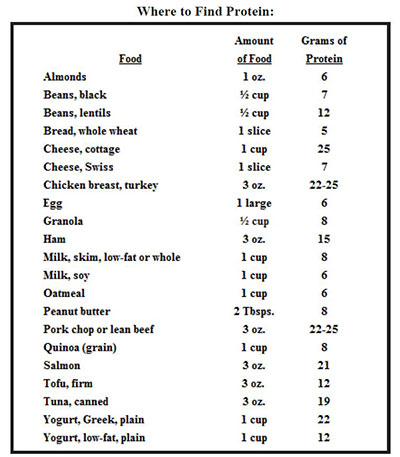The Power of Protein
Sheila Gains, Family & Consumer Science Extension Agent, Arapahoe County
Eat Protein at every meal – especially at breakfast!

Get your family off to a good start each morning with a serving of protein. Adults and growing children need protein to keep their bodies running smoothly. Protein is important for both physical strength and brain power. Every cell in the body needs protein. It is used by the body to build and maintain muscle, collagen, hair, hormones and enzymes.
Recommendations:
Children need more protein per pound of body weight than adults. Because children grow at different rates and at different times in their childhood, the amount of protein they need also varies. Unless your child is vegetarian he/she probably gets enough protein, but research is pointing to the need for a more even distribution of protein consumption throughout the day. A growing body of research evidence indicates that older adults benefit from an increase in protein consumption. The current Recommended Daily Allowance (RDA) for all adults is 0.8 grams (g) of protein/kg of body weight per day, but an increase to 1.0 g has been suggested for individuals over 65 to meet protein needs for optimal health.
Research suggests that it is particularly important to eat close to 30% of your daily protein at breakfast.
How Much Protein:
| Age | RDA in grams of protein per day to prevent disease |
30% to 45% RDA per meal, especially at breakfast! |
| Children, ages 1-3 | 13 g | 3.9 – 5.8 g |
| Children, ages 4-8 | 19 g | 5.7 – 8.5 g |
| Children, ages 9-13 | 34 g | 10.2 – 15.3 g |
| Girls, ages 14-18 | 46 g | 13.8 – 20.7 g |
| Boys, ages 14-18 | 52 g | 15.6 – 23.4 g |
| Adults, 150 lbs. | 54 g | 16.2 – 24.3 g |

Eating 30% of the recommended amount of daily protein at breakfast has several benefits. It helps you stay more alert in class or on the job, decreases unnecessary snacking and keeps you feeling fuller throughout the day. Spreading protein consumption throughout the day improves the use of protein by muscles and organs. Maintaining muscle mass helps your body recover from illness or injury and prevents osteoporosis. Muscles burn more calories at rest than fat. Higher muscle mass also reduces insulin resistance, important in controlling and preventing type 2 diabetes.
In one study of teenagers, the participants were divided into three groups. One group received a high protein breakfast, one a low protein breakfast and one group no breakfast at all. Then the teens were allowed to eat whatever they wanted for the rest of the day. The teens, who ate a high protein breakfast, had a greater feeling of fullness throughout the day, decreased evening food cravings and unhealthy snacking compared to those consuming a low protein breakfast or no breakfast at all.
Good sources of healthy protein include seafood, lean meat, poultry, eggs, beans, peas, soy products, dairy, nuts, and seeds and to a lesser amount some grains. Eat a variety of protein each day to get all necessary amino acids.
Let’s Talk
Explain to children the importance of eating protein, especially at breakfast. It helps them to be physically and mentally strong, better able to learn at school, and less hungry throughout the day. Ask children to help make a list of protein foods to have on hand for breakfasts. If rushed mornings are a challenge, have children help prepare protein foods the night before, such as assembling breakfast burritos, or baking On-The-Go Breakfast Mini Quiches (see recipe below). These can be quickly reheated in the microwave on a busy morning.
Recipe for Health:
On-The-Go Breakfast Mini Quiche
Makes 12

Ingredients:
1 tablespoon extra-virgin olive oil
1 cup shredded cheddar cheese
½ cup chopped white or yellow onion
1 cup low-sodium deli ham, cut into ¼-inch pieces
6 large eggs
1 cup 1% milk
2 tablespoons all-purpose flour
½ teaspoon pepper
Directions:
- Preheat oven to 350° F, grease a 12 count muffin pan withspray oil.
- Cover the bottom of each pan with half of the shreddedcheese.
- Heat olive oil in a skillet over medium heat.
- Add chopped onion and ham to the skillet and heat untilonions are soft and the ham is lightly browned. Set aside.
- In a bowl beat eggs and milk together until well blended. Add flour and mix until smooth.
- Add the ham and onion mixture, remaining cheese andpepper and mix lightly.
- Use a ladle to pour into muffin pan and bake 25 minutes,until firm or the center registers 165° F.
- Allow to cool before removing from pan. Refrigerate andstore in airtight container. Grab one for breakfast each morning!
Suggestion: Serve 1-2 mini quiches with whole wheat toast, fruit and milk.
Each Quiche Contains: 110 calories, 7.1 g fat, 200 mg sodium, 3.3 g carbohydrate and 8.1 g protein.
Recipe Source: Dining With Diabetes, Kendall Anderson Nu-trition Center, Colorado State University





